Fujifilm’s lenses and mirrorless cameras are a perfect combination for landscape photography.
There are plenty of sharp wide-angle zooms and primes with superb color and image quality.
In this guide, we went through all Fujifilm’s lenses to pick out the 8 best landscape options, whether you’re a professional or a beginner. We made sure to focus on image quality, versatility and how much you get for the price.
Best Fujifilm Landscape Lenses:
Fujifilm XF 14mm f/2.8 R
Fujifilm XF 16mm f/1.4 R WR
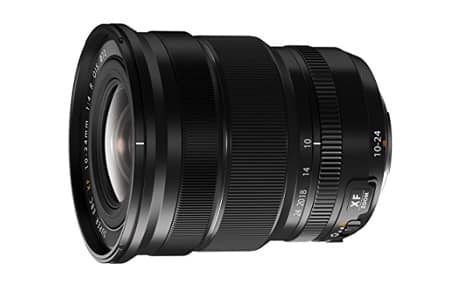 Fujifilm XF 23mm f/1.4 R
Fujifilm XF 23mm f/1.4 R
Fujifilm XF 23mm f/2 R WR
Fujifilm XF 10-24mm f/4 R OIS
Fujifilm XF 18-55mm f/2.8-4 R LM OIS
Fujifilm XF 18-135mm f/3.5-5.6 R LM OIS WR
Fujifilm XF 55-200mm f/3.5-4.8 R LM OIS
We discuss all of these lenses below, but first let’s go through what matters when buying a lens for landscape.
If you decide to buy anything after clicking on our Amazon links, you automatically support us. It’s what allows us to write guides such as this one.
What’s Important for Landscape Photography?
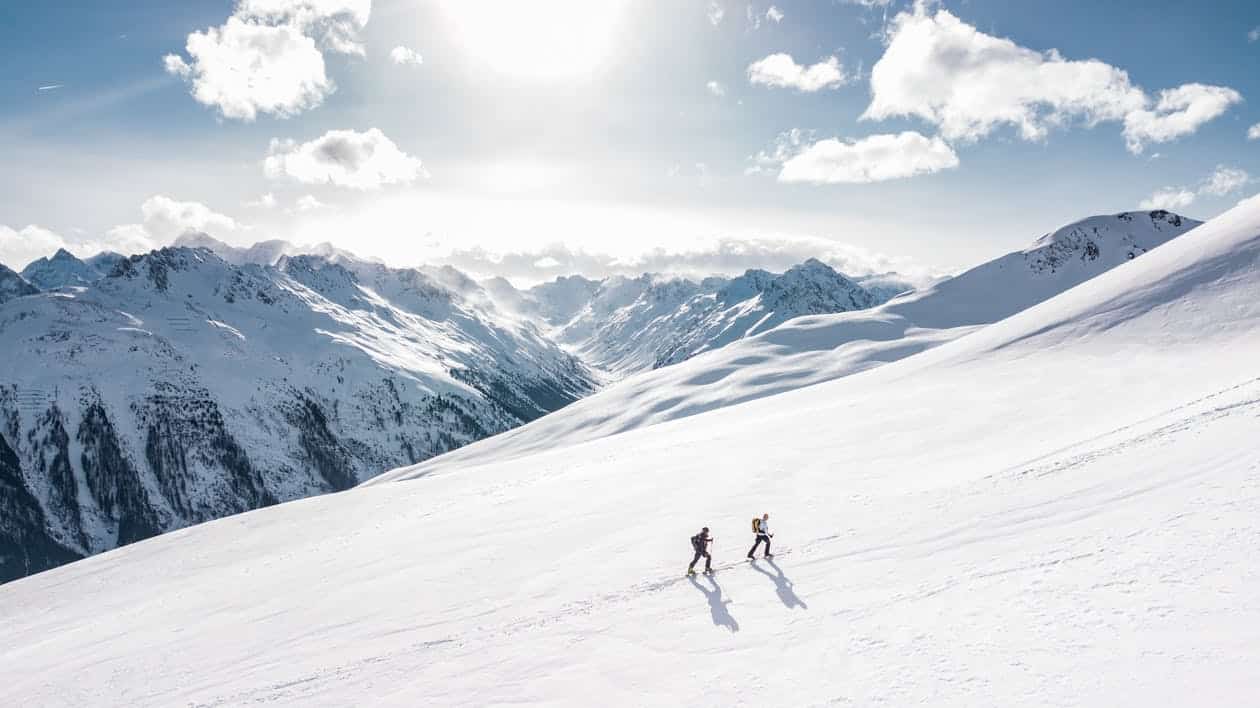
Here are the 5 most important factors that make a good landscape lens.
Focal Length – Wide angle lenses are most commonly used for landscape photography. Best focal length is anything under 23mm, since it allows you to capture plenty in your shot. Don’t underestimate telephoto ranges though, as many people also carry a lens that goes above 100mm. Why? Because when you’re hiking or traveling, a lot of amazing scenes aren’t directly in front of you, but far away. By having such a long zoom, you can isolate that specific part. Nonetheless, the majority of landscape shots are taken with wide angle lenses, zoom or prime.
Aperture – Most landscape photographers never shoot with big apertures, like f/1.4 or f/2.8. Instead, when you want everything sharp in your shot, you choose something like f/5.6, f/8 or even smaller, because the depth of field will be so small. The only scenario where having a big aperture would be useful is if you photograph at night and need as much light as possible, but unless that’s you, you shouldn’t worry about buying the lens with the biggest aperture if you know you will never shoot that big anyways.
Auto Focus – It’s great to have reliable and fast auto focus if you don’t have the time to focus manually. For traveling, hiking or just shooting on the go, all of the lenses below have good auto focus so you can expect shots that are perfectly in focus. However, many landscape shooters (that also carry a tripod) often prefer focusing manually.
Weight & Size – Photographing is fun, carrying a ton of heavy gear is not. Make sure to look at how big and heavy a lens is, especially if you always travel with lots of other stuff as well. While Fujifilm’s mirrorless cameras and lenses are great for landscape shooters due to their compactness, some people may still prefer carrying 1 zoom instead of a few primes, or simply just a pancake lens.
Image Stabilization – If you never use a tripod, having Optical Image Stabilization (OIS) is a wonderful feature. We are rarely 100% stable when taking pictures and having OIS will compensate for moving in any direction while taking the picture. OIS only works if your subject is static, and since landscape scenes don’t move, this is a perfect combination.
Image Quality – It’s all about image quality, sharpness and colors. You want good center and corner sharpness, especially if you print large. Fujifilm’s glass quality is great, and we made sure to select lenses that offer a lot for the money.
Fujifilm XF 14mm f/2.8 R
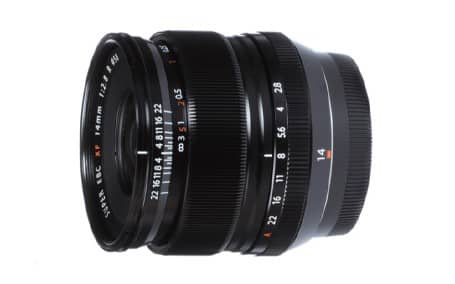
Landscape and architecture lovers will find the Fujifilm XF 14mm f/2.8 R lens a wonderful addition to their kit. Fujifilm lenses with the R designation have an aperture control ring allowing the user to make aperture adjustments on the lens as well as from the camera body.
At a fixed 14mm focal length this prime lens has a wide-angle field of view. The 1.6x crop factor of Fujifilm’s X-series sensors means the field of view of the 14mm f/2.8 is equivalent to 21mm on a full-frame sensor. The fast maximum aperture of f/2.8 means rapid shutter and autofocus speeds are achievable even in low light situations.
Sharpness and resolution are also maximized from the center to the periphery with no loss at the edges of the frame. At .52 lbs the lens is also extremely lightweight and comfortable to handle.
The XF 14mm also has molded aperture blades designed to enhance bokeh at the wider aperture settings. Bokeh are out of focus elements that appear as dream-like spheres in out of focus areas.
But the focal length and sharpness of this lens is better suited to landscape, indoors and architecture photography which means you’ll usually be using higher aperture values. Bokeh enhancement is a great bonus but may not come into play all that frequently.
You can buy it at Amazon or see more reviews here.
Fujifilm XF 16mm f/1.4 R WR
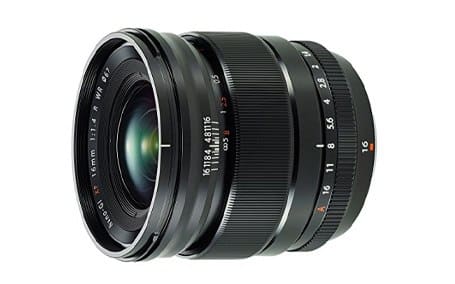
The Fujifilm XF 16mm f/1.4 R WR is a wide-angle lens with a wide maximum aperture and a host of intriguing features. The field of view is equivalent to 24mm using a full frame 35mm sensor. Like all Fujifilm lenses with the R designation the 16mm f/1.4 R WR has an aperture control ring which allows the photographer to adjust aperture on the lens itself.
This lens also includes a depth-of-field scale on the focus ring for instant distance calculations. Combined with a minimum focusing distance of 6 inches this lens is incredibly versatile.
The fast f/1.4 aperture combined with a two-group floating focus system allows for auto focus speeds as quick as 0.11 seconds. And the nine rounded diaphragm blades work to enhance the bokeh of the background when used at maximum aperture.
Nine weather and dust seals in eight locations keep out unwanted elements and allow the lens to function at temperatures as low as 14F (-10 C). Lastly the Nano GI (Gradient Index) coating of the glass alters the refractive index between the lens glass and the air. The result is less ghosting and flare from incidental lighting.
At .83 lbs this lens is a little weightier than the others. Still, the XF 16mm is the premiere choice for travel, street, nature and landscape photographers.
You can buy it at Amazon or see more reviews here.
Fujifilm XF 23mm f/1.4 R
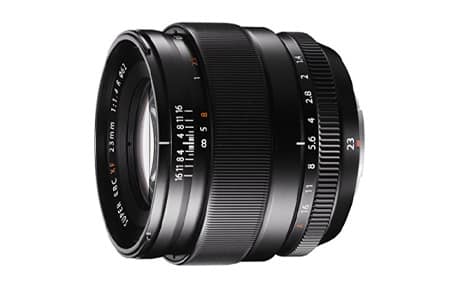
The Fujifilm XF 23mm f/1.4 R lens is perfect for photographers looking for a field of view that will always be useful.
With the Fujifilm’s X-series’s APS-C sized sensor the XF 23mm has a 35mm equivalent field of view. 35mm is incredibly versatile as it’s the field of view closest to that of the human eye. This makes this lens great for nearly any application including portraits, landscapes, architecture, and natural scenery.
Wedding and event photographers will find the f/1.4 maximum aperture especially pleasing. The fast aperture is perfect for low light photography and creates extremely shallow depths of field. The seven rounded aperture blades ensure beautifully artistic bokeh as well.
The glass has a multi-layered High Transmittance Electron Beam Coating (HT-EBC) that protects the surfce of the lens from scratching. The HT-EB coating also keeps light from scattering and ensures image contrast remains rich and vibrant.
The lens can focus as close as 11 inches with the close-up focusing control enabled or two feet when operated normally. It also has a camera to subject distance indicator and a depth of field scale on the barrel of the lens to aid manual prefocusing.
With a length of 2.84 in. and just 0.66 lbs in weight the 23mm f/1.4 R is the smallest and lightest non-pancake lens in this series. While it lacks the weather sealing of the 23mm f/2 R the faster aperture makes it the superior choice if cost is not an issue.
You can buy it at Amazon or see more reviews here.
Fujifilm XF 23mm f/2 R WR
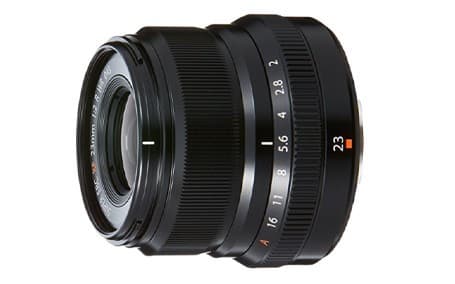
The Fujifim XF 23mm f/2 R WR is a rugged version of the 23mm f/1.4 R. At half the price, the f/2 R WR is a strong challenger. Although the aperture is not as wide f/2 is still a great aperture for portrait and event photography. It also allows for good performance in challenging lighting conditions. Plus, for landscape, the difference won’t matter in 99% situations.
The weather sealing of the f/2 R WR helps ensure the elements don’t penetrate, making it an excellent lens for nature and landscape photographers. This added protection allows normal operation down to 14 F (-10 C).
Although the field of view of the XF 16mm f/1.4 R WR is perfect for landscape lovers, the 23mm view of this lens is a 35mm equivalent on a full-frame sensor. 35mm is closest to the view of the human eye, making the XF 23mm f/2 a more versatile outdoor lens for scenes beyond landscapes. Also, the wider aperture makes the f/1.4 R WR more expensive when you’ll need narrower apertures anyways in landscape photography (deeper depth of field).
The glass of this lens does not have the layered High Transmittance Electron Beam Coating (HT-EBC) of the 23mm f/1.4 R. Nor does it have the Nano-GI layer of the 16mm f/1.4 WR. Overall, the 23mm f/2 R WR is a weather sealed middle ground lens but has slightly less image sharpness and clarity compared to its higher priced siblings.
You can buy it at Amazon or see more reviews here.
Fujifilm XF 10-24mm f/4 R OIS

The Fujifilm XF 10-24mm f/4 R OIS is a zoom lens well suited for architecture and street photographers who want a wide-angle field of view. This range is also great for landscape photographers who need the expansive view.
OIS stands for Optical Image Stabilization; the f/4 R has built in elements to help control motion blur due to hand shake. This allows photographers to shoot handheld without sacrificing sharpness.
With a minimum focusing distance of 9.5 in (24 cm) this lens works well as a macro photography lens. And with the wide-angle field of view the surroundings of the main subject will also be in full view. But with a maximum aperture of f/4 the user won’t be creating bokeh filled images.
The 10-24mm f/4 R also has a High Transmittance Electron Beam Coating (HT-EBC) to moderate lens flare and ghosting. The result is a boost in contrast and a reduction in chromatic aberration. The layer also protects against scratches. Lastly, this lens can pair with Fujifilm cameras that have a Lens Modulation Optimizer (LMO) setting to ensure exposure and sharpness remain consistent across the entire frame.
As a zoom lens it’s not directly comparable to the 14mm or 16mm lenses listed here. For photographers who want a shallower depth of field the prime lenses are the obvious choice. But if the user prefers scenes that need greater depth of field, then this lens provides a wider range of focal lengths without sacrificing image quality.
You can buy it at Amazon or see more reviews here.
Fujifilm XF 18-55mm f/2.8-4 R LM OIS
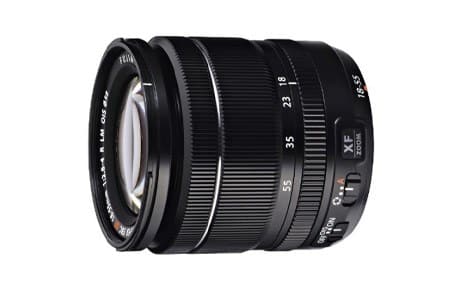
The Fujifilm 18-55mm f/2.8-4 R LM OIS is very similar in design to the 16-55mm f/2.8 but lacks several key features that help bring the price down.
This lens does not have weather resistance, so it needs to be protected in rough environmental conditions. Also, the lens stops down to f/4 maximum at the telephoto end. This means you’ll only get bokeh and shallower depths of field at the wide-angle end which may not be all that useful.
The focal length range is equivalent to 27-84mm full-frame lens which is an incredibly versatile wide angle-telephoto range. That makes it great for everything from portraits to architecture. Overall, this is a great street photography lens. Plus, at .68 lbs (10.88 oz) this lens weighs half as much as the 16-55mm f/2.8.
The built in OIS (Optical Image Stabilization) helps keep image blur from becoming an issue while shooting handheld. With up to four stops of IS, a user who needs a minimum of 1/500ths of a second to avoid motion blur normally can instead use 1/30ths of a second and have the same chance of blurring.
Lastly the Nano GI (Gradient Index) coating of the glass alters the refractive index between the lens glass and the air. The result is less ghosting and flare from incidental lighting.
You can buy it at Amazon or see more reviews here.
Fujifilm XF 18-135mm f/3.5-5.6 R LM OIS WR
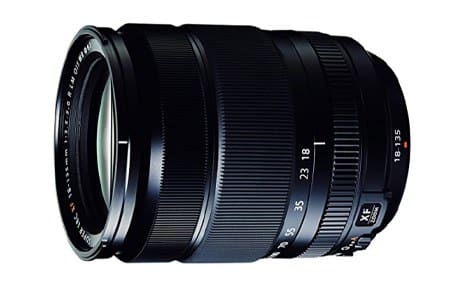
The Fujifilm XF 18-135mm f/3.5-5.6 R LM OIS WR is an extremely versatile lens meant to cover a wide variety of subjects. Everything from landscapes and architecture to portrats and wildlife are all possible with this lens.
Using the APS-C sized sensors for the X-series cameras the focal range is equivalent to a versatile 27-206mm on a full-frame body. The aperture is not very fast, however, which is typical of zoom lenses in order to cut costs. f/3.5 won’t give a wafer-thin depth of field no matter the focal length. But the tradeoff is incredible versatility in captures in all weather conditions.
Shooting handheld with this lens is a pleasure even at 135mm. The lens combines the Linear Motor (LM) design with optical image stabilization (OIS) elements to create powerful motion blur compensation. Five stops of image stabilization help keep photos sharp even shooting handheld in low light settings.
As a WR (weather resistant) lens the XF 18-135mm has 20 seals to prevent dust and moisture from penetrating the interior of the lens. The lens can even operate in temperatures as low as 14F (-10C) making this a great choice for nature photographers who won’t let snow and rain keep them from getting the best shots.
The glass of this lens is coated with a High Transmittance Electron Beam Coating (HT-EBC) to reduce ghosting, lens flare, and chromatic aberrations. Image sharpness and contrast remain optimized. Also, the coating provides extra scratch protection.
You can buy it at Amazon or see more reviews here.
Fujifilm Lens Terms:
XF – Highest quality Fujifilm lenses for X-mount (X-T2, X-T1 and so on)
WR – Weather Resistant construction
R – The lens has a dedicated aperture ring
OIS – Optical Image Stabilization
LM – Linear Motor, allows faster and near silent focusing
Our Top Fujifilm Landscape Lenses:
Fujifilm XF 14mm f/2.8 R
Fujifilm XF 16mm f/1.4 R WR
 Fujifilm XF 23mm f/1.4 R
Fujifilm XF 23mm f/1.4 R
Fujifilm XF 23mm f/2 R WR
Fujifilm XF 10-24mm f/4 R OIS
Fujifilm XF 18-55mm f/2.8-4 R LM OIS
Fujifilm XF 18-135mm f/3.5-5.6 R LM OIS WR
Fujifilm XF 55-200mm f/3.5-4.8 R LM OIS
We have also prepared a couple of Fujifilm landscape tutorials/guides for you. Here’s one on what settings to use for landscape, and one general tips for getting the best possible pictures from Fujifilm blog.
Last Updated on January 19, 2022 by Nick Voorhees
First and foremost, I’m a husband and father. Then professionally I’m photographer, designer, blogger, and Esty store owner. My homebase is near the stunning Wasatch mountains in Utah but I love traveling with my family as part of our homeschooling journey. I also love teaching and helping out others. My faith is one of the biggest aspects of my life and brings be a consistent joy that I haven’t found in anything else. My main blog is BestPhotographyGear.com and I strive to make photography simple for anyone looking to learn or find gear for their individual needs. By nature, I like to study, research, and analyze things and I use that help provide the best advice and reviews I can.
